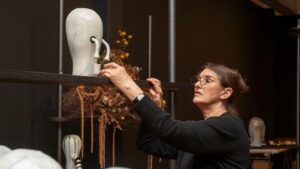
02 Jul Sarjeant Gallery: Julia Morison’s Head [case] installation is all about the senses

Julia Morison’s Head [case] installation is on at the Sarjeant Gallery until August 22.
Head [case], the installation by Julia Morison at the Sarjeant Gallery, given the title, is a surprisingly visceral experience. But then it is about the senses, which can evoke strong emotions – curiosity, joy, fear, revulsion, sadness, disgust and more – the 100 ceramic heads attract a huge range of responses. Head [case] shows until August 22, 2021.
The head is a portal to all the senses but the exhibition is entirely visual with some background music so it also appeals to the imagination, to memory and the different sensory experiences of viewers.
“It’s about the holes in the head really – what goes in, what goes out and how that can be altered by accessories. When you take glasses off vision is quite different. Some heads just invite an experience with the surface as there are no holes to pass a sense through,” Morison said. “It’s interesting how people respond to the exhibition. It’s hard to predict – there’s humour, aversion, I think they are bringing their own baggage to it. People have a history of things I have no knowledge of.”
Morison says she is fascinated by heads and, like many artists, is very interested in perception.
“I think it is just fascinating that we all live in the same world, supposedly – I don’t know if that’s a fact or not – but my world is very different from your world – what we soak up and also what we decide to put out or take note of, and if we act, what those actions emit.”
The heads that are all modelled on a hat-maker’s block are arranged in a honeycomb, or hexagonal structure, which forms a geometrical foundation for the exhibition. The structure is divided into seven “rooms” through which viewers can wander.
Morison has used the Sefirothic Tree of Life (Kabbalah) as a structure for many projects and Head [case] is also quite loosely based on this – a set of symbols working from the square up to the circle and including “positive materials” like silver, gold and lead with the clay.
Along with her preference for formalism Morison has a long-term interest in alchemy, Jungian psychology, surrealism and comparative religious symbolism, which she developed during her fine arts studies at the University of Canterbury. Previously, at design school she was used to working from a brief and said she needed a structure, adopting that of the Sefirothic tree, which she says is limitless.
“While its systems are very ancient they are also very contemporary I think. I layer them up; it’s a form of collage.”
The catalogue that accompanies the exhibition includes a diagram of the structure and full-page photographs of every head.
Teeth are a recurring image. A head entitled A Mouthful of Teeth scatters ceramic teeth in front of the head, each tooth attached by a thread through the puckering mouth. Teeth falling out is a common nightmare. An Italian psychologist and dentist used a photograph of this head and one held in the Auckland Art Gallery collection to illustrate his book on dental psychology.
Tear Catcher 2014 with buckets under its eyes references artist David Cross who, she was told, has no tear ducts.
“He does performance work where he collects his tears. I found that so interesting so I made that response – a tear collector head sculpture.”
The exhibition has shown at galleries around New Zealand and it fills the main space at the Sarjeant on the Quay.
“This is the original configuration commissioned by the Christchurch Art Gallery, slightly altered to fit into a smaller space and to accommodate the pillar.
“At Object Space in Auckland there was no space around it as in other galleries. You just walked right into it; it was much more immersive. Here you can walk past it and also walk through its maze-like structure.”
Morison is also well-known as a painter, which she continues to do. She was appointed an Officer of the New Zealand Order of Merit in 2018 for services to visual arts and has won many other prestigious awards.
By: Helen Frances
This article first appeared in the Whanganui Chronicle and online in the NZ Herald on 27 June 2021

